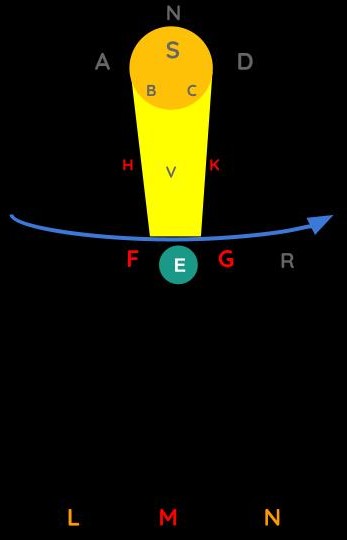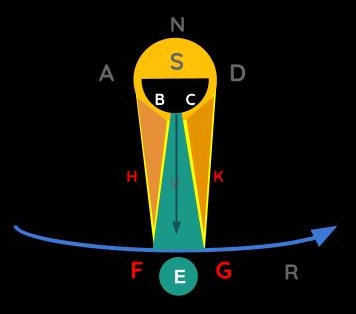Solar Wind and Black Holes
Table of Contents
Solar Wind: How Do They Radiate from the Sun?
The stellar air-aether [invisible spacetime particles] is continually pushed by 2 phenomena:
- By their fellow air-aether between them and the star at the center of their gravitational territory
- By the fire-aether [visible electromagnetic particles] of that star*.
Superphysics Note
They are not pushed at all by the others [beside them].
For example, those at E are not pushed by those at M, G, F, K, or H, but only by all those that are between the two lines AF and DG together with the fire-aether of the sun.

That is why they tend not only towards M, but also towards:
-
L, -
N, and -
generally all the air-aether that are in a straight line from the points on the sun.
To explain this outward motion, let us imagine the sun as a void.
Black Holes
Imagine the air-aether particles at E were all alone and that there was absolutely no light (fire-aether) anywhere, even where the sun is.

-
If that air-aether at
Edisappeared, then the air-aether beyond circleFEG, say atM, will not fill its place since it tends to move away from it. -
The air-aether at
Fwill also not fill it. This is because it is moving towardsGwith the same speed as it goes toR.
The void at E will move with them as long as others do not come from elsewhere to fill it.
- The air-aether within the circle
FEGbut beyond the linesAFandDG, such as those atHandK, will also not fill it.
- This is even if their tendency to move away from
Sdisposes them in some way. This is similar to how a rock’s weight disposes it to fall in a straight line and roll down a mountain sideways if it cannot fall straight down.
But such air-aether do not fill that void because of the continuous straight-line motions.
Nature always chooses the shortest way to arrive at the same effect.[57]
- This is why the air-aether must travel in a straight line.
- The continual straight-line motions impedes the air-aether from going into
E.
If the air-aether at K advanced towards E and filled it, then the air-aether at the Sun S would take the place of K.
- But this would create a new void at the circumference
ABCDof the sun at the same time
But shortest way would be for the air-aether between the lines AF and DG advance straightaway towards E.
- But by the time that air-aether reaches
E,Ehas moved away. - It cannot curve to chase
Ein the same way that a falling rock falls straight down and not in a curve.
The air-aether between the lines AF and DG must advance together towards space E in order to fill it when it becomes void.
Only their inclination to move away from point S carries them toward E.
- This inclination causes those between the lines
BFandCGto tend to move more directly towardsEthan those that remain between the linesAFandBF, andDGandCG. - These latter parts are also disposed as the others to go there.
The effect is that:
- space
Eis filled - a space of equal size in the circumference
ABCDbecomes void at the same time
The air-aethers are completely alike, but not all equal.
- It does not matter which of them fill these places.
- The motions that can cause them to be unequal are irrelevant.
The shortest way to fill E is for the air-aether at D to go to E via lines DG or DE.
If the air-aethers between the lines BF and CF advanced first towards E, then they would cause V to be void.
Dwould then have to fill this.- This would create a curved line
DVE* just to fillEinstead of a straight lineDG, orDE.
- This would create a curved line
- This is contrary to my rules of motion.